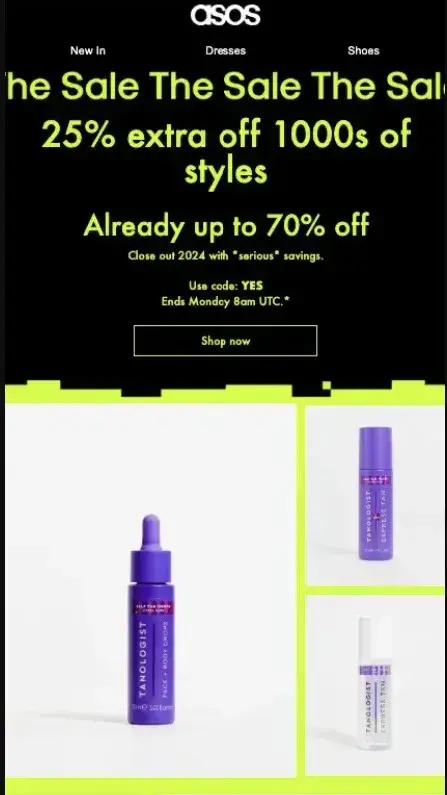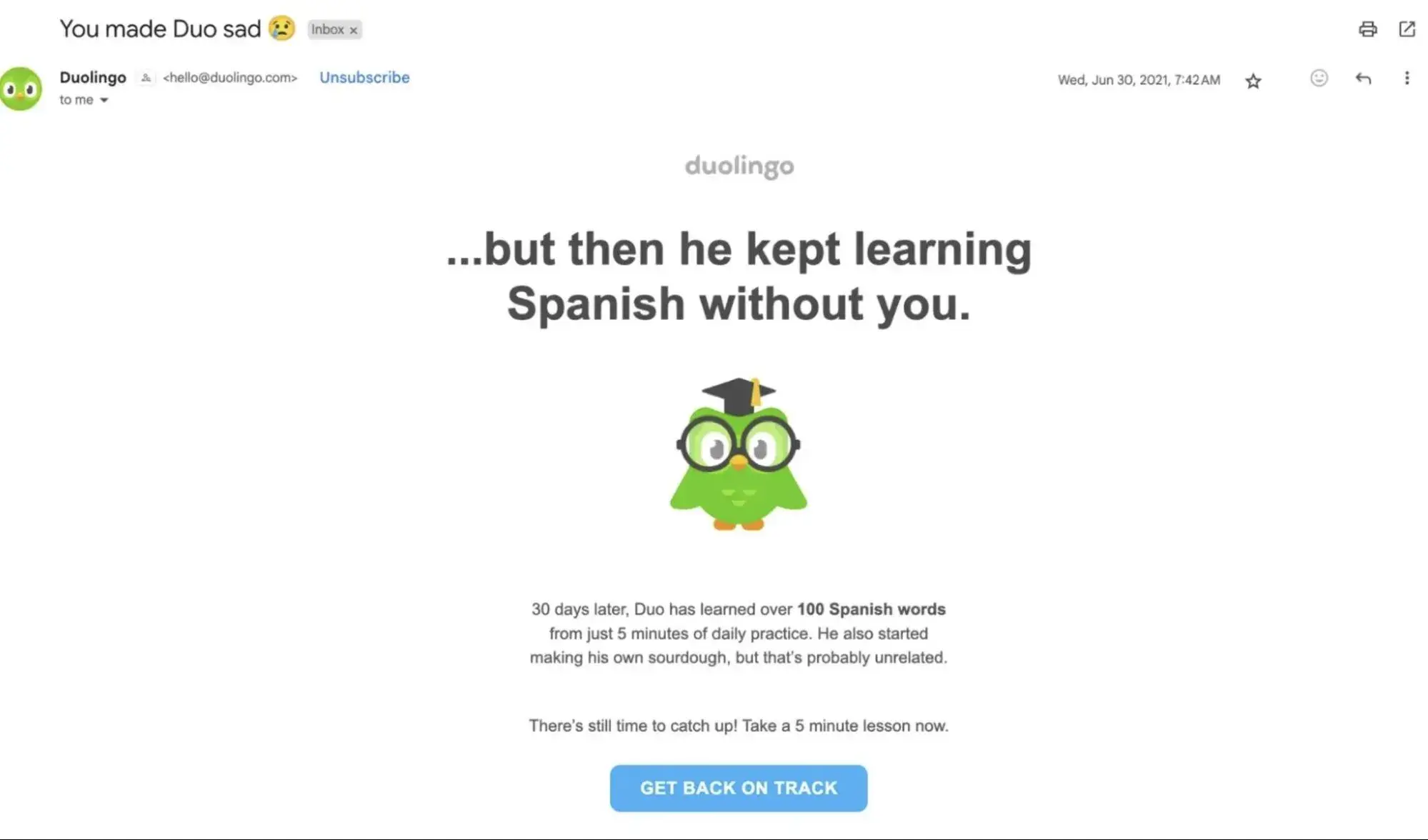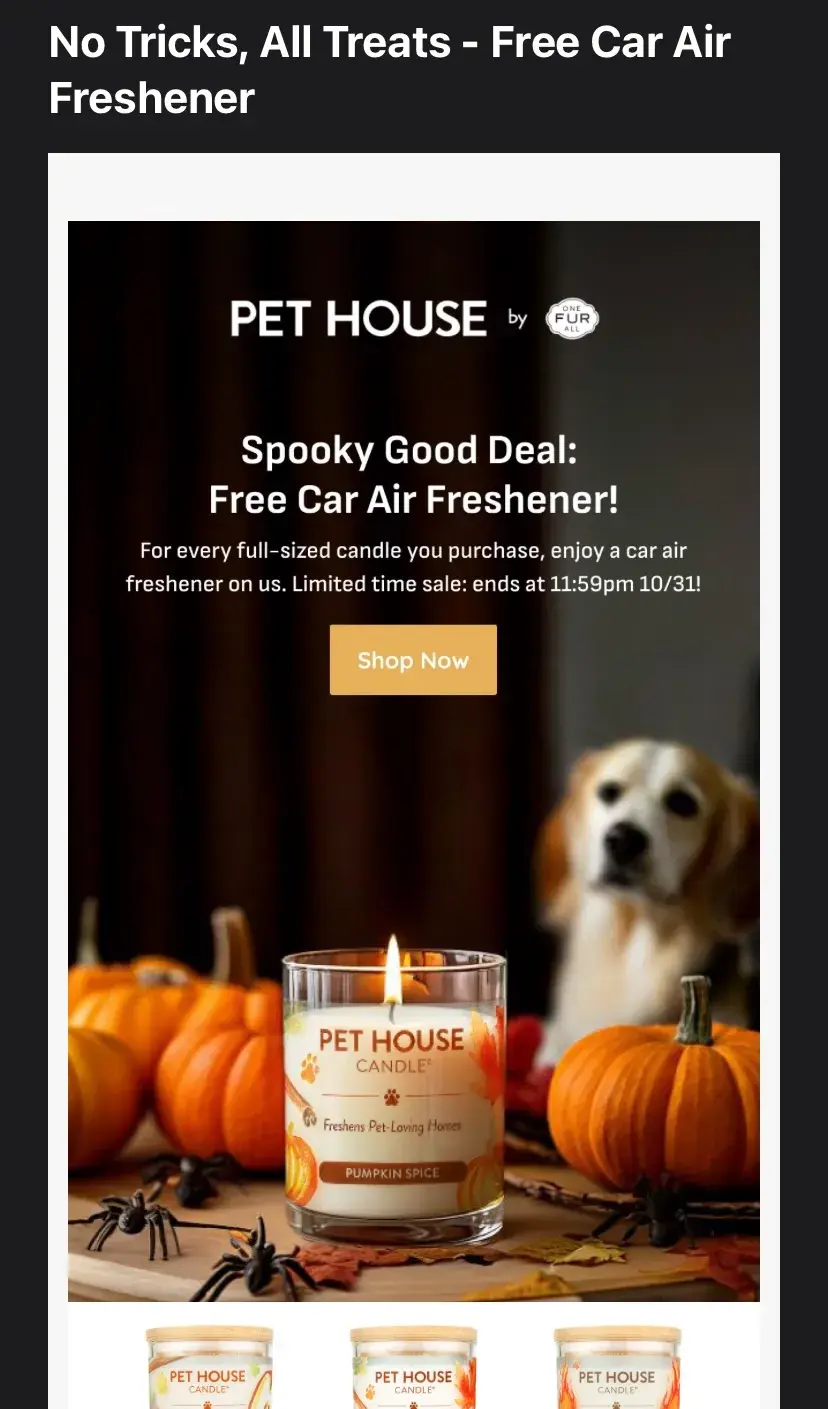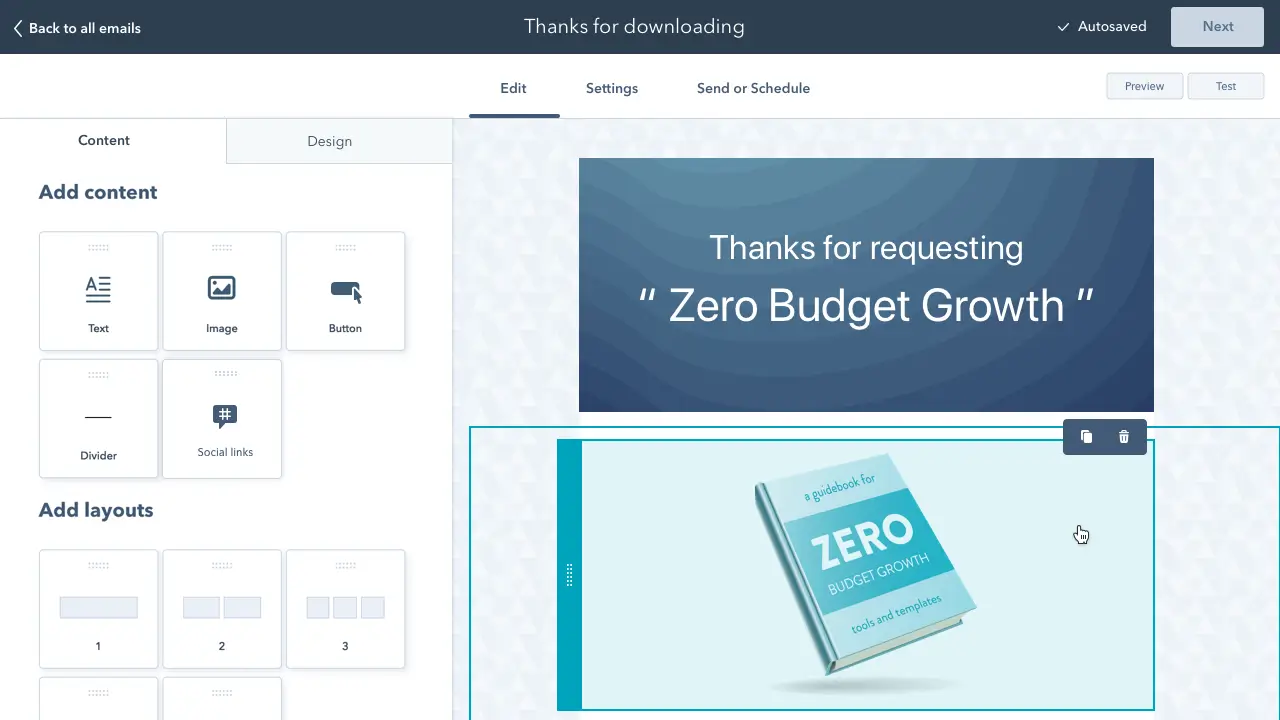In this comprehensive email marketing guide, I'll walk you through everything from best practices to building your first campaign to advanced strategies that drive results. Whether you‘re launching your first email or optimizing an existing program, you’ll learn the proven tactics that make email marketing 40 times more effective at customer acquisition than social media.
Table of Contents
- What is email marketing?
- How to Send Marketing Emails
- Benefits of Email Marketing
- Types of Marketing Emails
- How to Create an Email Marketing Strategy: 9 Essential Steps
- How to Build Your Email List
- Email Marketing Stats You Should Know
- Email Marketing Compliance: Essential Regulations and Best Practices
- Email Marketing Tips
- Email Marketing FAQ
The goal is building customer relationships, promoting products or services, increasing brand awareness, and ultimately driving sales.
In my experience, email marketing allows me to reach my target audience directly with personalized and relevant content. It’s also cost-effective, easy to track, and provides valuable data for analyzing campaign success.
Marketers have been using email as a channel for almost as long as they’ve been using the internet. The first marketing email was sent in 1978, resulting in $13 million in sales.
Email has been one of the most highly used marketing channels ever since.
This is because email is a flexible yet cost-effective way to reach many people relatively quickly. I can also personalize my message to target specific audiences and generate leads.
Email marketing can take many different forms. These campaigns can include a single email announcing new content, an ongoing newsletter delivered regularly, or contacting customers about product updates.
Email isn’t as shiny as newer channels, like messaging and social. However, email is an effective way to build an audience that gets results.
“One of my favorite parts about email marketing is its intimacy,” says Rob Litterst, head of strategy and operations for HubSpot’s Newsletter Network.
“Access to someone’s inbox is sacred, and for a person to welcome you in, there’s already a certain level of trust that you just can’t achieve with other platforms,” he says.

Master the fundamentals of email marketing with a free online course.
When to Use Email Marketing
Email marketing remains a powerful tactic to:
- Build relationships. Build connections through personalized engagement.
- Boost brand awareness. Keep your company and your services top-of-mind for the moment when your prospects are ready to engage.
- Promote your content. Use email to share relevant blog content or valuable assets with your prospects.
- Generate leads. Entice subscribers to provide their personal information in exchange for an asset that they’d find valuable.
- Market your products. Promote your products and services.
- Nurture leads. Delight your customers with content that can help them succeed in their goals.
Benefits of Email Marketing
Email marketing has steadily proven itself as a powerful channel for reaching and engaging your audience. It offers a mix of personal touch and cost-effectiveness that many other channels just can’t match. Let’s dive into some of the key benefits you can harness when you add email to your marketing strategy.
1. Cost-Effective
Email marketing is budget-friendly compared to traditional advertising methods like print ads or television commercials. Most email platforms offer affordable plans, and sometimes even free options, that still pack a punch in delivering your messages.
Since you don’t have to invest heavily in expensive media placements, you are free to experiment more, refine your campaigns, and allocate resources to other creative or strategic projects.
Moreover, email marketing has a high return on investment (ROI), making you an average of $36 for every $1 spent.
2. Direct and Personalized Communication
One of the reasons I rate email marketing so highly is because it gives you the ability to deliver personalized messages straight to your audience’s inbox. I’ve experienced firsthand how personal touches, like addressing me by my name or referencing a previous interaction we’ve had, has made me fall in love with a brand and made me look out for every email they send me.
By segmenting your email list based on factors like purchase history or interests, you can make each email feel like it was written just for that person. It’s like having a one-on-one conversation with your customers.
3. Strengthened Brand Awareness
Every time you send an email, you get a chance to reinforce your brand’s identity. With consistent messaging, carefully chosen images, and a unique tone of voice, your emails help establish who you are and what you stand for. Over time, this builds a strong association between your brand and the quality or value you provide.
Your subscribers start to recognize your style and look forward to your emails, which is exactly the kind of lasting impression you want to create. Whether it’s through eye-catching designs or thoughtful content, each email adds another brushstroke to the overall picture of your brand.
4. Measurable Results and Insights
With email marketing, every send and every click is trackable. This level of measurement is a game-changer because you always know what’s working and what isn’t. You can look at open rates, click-through rates, bounce rates, and even conversion rates to see where you might improve.
For example, if a particular subject line isn’t performing well, you can adjust it and test a new approach the next time. This constant feedback loop means you’re always learning and evolving, so your campaigns get better with each send.
5. Increased Customer Engagement and Loyalty
Consistency is key when it comes to building lasting relationships with your customers. With email marketing, you get the chance to stay in regular contact with your audience by sharing news, special offers, or insightful content. This regular engagement isn’t just about selling — it’s about building a community around your brand.
When I still ran my beauty blog, I liked to think of my (very small) email list as a group of friends who trusted my advice and recommendations. Over time, that trust translates into customer loyalty, and loyal customers are more likely to stick with your brand for the long haul.
6. Increased Conversion Opportunities
Every email is a chance to drive your audience toward a goal, whether that’s making a purchase, signing up for an event, or simply visiting your website. By including clear calls-to-action (CTAs) in your emails, you guide your readers step-by-step through the customer journey.
“While it’s the second-most used marketing channel (beat by social media), a whopping 95% of email marketers call it practical,” says Pamela Bump, head of content growth at HubSpot.
“For HubSpot — and our blog team — we’ve deeply leveraged email and even catered blog posts to our very subscribers,” she says. “Over the years, this has driven high ROI, millions of page views, countless conversions, and even customers.”
A great way to increase conversions is to experiment with different CTA placements and phrasing to see what resonates best with your audience. For example, you can shift your CTA button closer to the top of the email to see if it’ll result in more click-through rates. It may sound simple, but these tweaks can make a big difference in turning interest into action.
7. Automation and Scalability
As your business grows, so does the challenge of staying in touch with every customer. Email sequence software comes with powerful automation tools that let you schedule emails or even trigger messages based on user actions — like a thank-you email when someone makes a purchase.
This means you can “set it and forget it” to a large extent. For example, when I ran the email marketing for a literary website, I set up an automated email series that nurtured leads over days or even weeks. This saved me countless hours while still delivering a personalized experience to every subscriber.
Automation not only helps you scale your efforts but also ensures that each customer journey is smooth and consistent.
Types of Marketing Emails
Email marketing isn’t a one-size-fits-all approach. Depending on your audience, goals, and the current stage of your customer journey, you can adopt various email types to engage your audience effectively. Here are some common types of email marketing that you can send to your customers (with examples from my own inbox):
1. Welcome Emails
Your welcome email sets the tone for your entire relationship. It typically sees the highest engagement rates of any email type — often 50% higher than standard campaigns.
Best practices:
- Send immediately after signup
- Include a clear value proposition
- Offer a welcome incentive
- Set expectations for future emails
Here's a welcome email from Strava, the running app:

What works: The cheerful headline creates an immediate connection. Multiple CTAs show different ways to get value, while the testimonial provides social proof. This helps new users understand exactly what they can achieve with the app.
2. Promotional Emails
Promotional emails drive immediate action through special offers, discounts, or limited-time deals. They're your direct sales tool.
Key elements:
- Clear discount or offer
- Urgency indicators
- Prominent CTAs
- Product visuals

What works: ASOS combines a compelling 70% discount with personalized product recommendations based on browsing history. The deadline creates urgency while multiple product images provide options.
3. Newsletters
Newsletters nurture long-term relationships by delivering consistent value. They keep your brand top-of-mind between purchases while establishing your expertise.
Effective newsletters include:
- Industry insights and trends
- Educational content
- Company updates
- Curated resources

What works: Omniscient Digital's newsletter delivers deep, actionable insights without fluff. Each edition teaches something valuable, building loyalty through expertise.
4. Transactional Emails
Triggered by user actions, transactional emails have the highest open rates (often 80%+) because recipients expect them. Use this engagement opportunity wisely.
Common transactional emails:
- Order confirmations
- Shipping notifications
- Password resets
- Account updates

What works: Amazon provides all essential information while adding product recommendations to increase order value — turning a service email into a sales opportunity.
5. Re-engagement Emails
Win back inactive subscribers before they're lost forever. These emails acknowledge the relationship gap and offer reasons to return.
Re-engagement tactics:
- Exclusive “we miss you” offers
- Account activity reminders
- Preference update options
- Emotional appeals

What works: Duolingo's emotional approach humanizes their brand mascot, creating guilt-free motivation to return. The simple CTA makes re-engagement effortless.
6. Abandoned Cart Emails
Recover lost sales by reminding customers about items left behind. These emails generate 29% of all email marketing revenue despite being sent to a small segment.
Abandoned cart essentials:
- Product images and details
- Easy return-to-cart button
- Limited-time incentive
- Alternative payment options

What works: FashionNova's 50% discount creates irresistible urgency. Buy-now-pay-later options remove financial barriers while product recommendations increase average order value.
7. Lead Nurturing Emails
Lead nurturing emails contain valuable information that is relevant to consumers at different stages of their buyer's journey.
Lead nurturing emails typically:
- Address pain points
- Offer solutions
- Are personalized and relevant

What works: Warby Parker's lead-nurturing email effectively addresses the issue of excessive screen time and the problems it causes for its target audience. Wrby Parker points recipients to a solution offered by the eyewear brand, which includes anti–fatigue glasses and blue-light-filtering lenses.
8. Dedicated Emails
Dedicated emails are designed to notify recipients of specific products, offers, or services. Dedicated emails often include calls to action, urgent language, and images of products and services up for grabs.

What works: The email is clever and well-formatted to fit the season, with “No Tricks, All Treats” being a fitting theme for Halloween. This dedicated email example also includes the most important information in the subject line (“Free Car Air Freshener”).
How to Create an Email Marketing Strategy: 9 Essential Steps
Building a successful email marketing program requires strategic planning. These nine steps will guide you from initial setup through ongoing optimization, ensuring every campaign drives measurable results.
Step 1: Define your target audience.
Before writing a single email, understand who you're talking to. Effective campaigns start with detailed buyer personas that capture:
- Demographics and firmographics
- Pain points and challenges
- Content preferences
- Buying behavior patterns
Use HubSpot's Marketing Analytics software to gather behavioral data that informs your personas.
Step 2: Set clear, measurable goals.
Your email marketing goals should align with broader business objectives. Start by researching industry benchmarks.
Common email marketing goals include:
- Increase email list by 25% in Q1
- Achieve 30% open rate on promotional emails
- Generate 100 qualified leads per month
- Improve click-through rate by 10%
Step 3: Choose the right email marketing platform.
Your email service provider (ESP) is the foundation of your program. Essential features to consider:
Must-have capabilities:
- List segmentation and personalization
- Automation workflows
- A/B testing functionality
- Mobile-responsive templates
- Detailed analytics and reporting
- CRM integration
- Compliance tools (GDPR, CAN-SPAM)
Platform recommendations by business size:
- Small businesses: HubSpot (free tier available), Mailchimp, Constant Contact
- Growing companies: HubSpot Marketing Hub, Mailjet, ActiveCampaign
- Enterprise: Salesforce Marketing Cloud, Adobe Campaign, Oracle Eloqua
Step 4: Build your email list (the right way).
Quality beats quantity every time. Focus on attracting engaged subscribers who want to hear from you.
Effective list-building tactics:
- Create valuable lead magnets (ebooks, templates, tools)
- Add signup forms to high-traffic pages
- Use exit-intent popups strategically
- Offer exclusive content or discounts
- Run social media campaigns
- Host webinars or events
Never buy email lists — they damage deliverability and violate regulations.
Step 5: Develop your content strategy.
Map email content to your customer journey stages:
Awareness stage:
- Educational newsletters
- Industry insights
- How-to guides
Consideration stage:
- Product comparisons
- Case studies
- Free trials or demos
Decision stage:
- Customer testimonials
- Limited-time offers
- Personalized recommendations
Step 6: Design for engagement.
Your emails compete with dozens of others for attention. Stand out with:
Design best practices:
- Mobile-first layouts (60%+ of emails open on mobile)
- Clear visual hierarchy
- Contrasting CTA buttons
- Alt text for images
- White space for readability
- Brand consistency
Step 7: Create your email calendar.
Consistency builds trust. Develop a sending schedule your audience can rely on:
Sample email calendar:
- Weekly newsletter: Tuesdays at 10 AM
- Monthly product updates: First Thursday
- Promotional emails: Maximum 2 per month
- Transactional emails: Real-time triggers
Inform subscribers about your schedule upfront to set expectations.
Step 8: Implement testing and optimization.
Every audience is unique. Use A/B testing to discover what resonates:
Elements to test:
- Subject lines (length, personalization, emojis)
- Send times and days
- CTA placement and copy
- Email length
- Image vs. text ratio
- From names
Madison Zoey Vettorino, former HubSpot marketing manager, emphasizes: “A/B testing is an excellent way to determine if changes will be successful before implementing on a larger scale.”
Step 9: Measure, analyze, and iterate.
Track these essential KPIs:
Primary metrics:
- Deliverability rate: Aim for 95%+
- Open rate: Industry average 15-25%
- Click-through rate: Target 2-5%
- Conversion rate: Varies by goal
- Unsubscribe rate: Keep under 0.5%
Advanced metrics:
- Revenue per email
- List growth rate
- Email sharing/forwarding rate
- Overall ROI
Use insights to continuously refine your strategy. What worked last quarter might need adjustment as your audience evolves.
Pro tip: Campaign Assistant, HubSpot's AI tool, can help you quickly write effective email copy aligned with your campaign goals.
How to Build Your Email List
Now, to my favorite part: filling the email list with eager prospects who are excited to hear from you.
There are many creative ways to build your email list (and, no, purchasing emails ain’t one).
Tactically speaking, list building comes down to two key elements that work cohesively to grow your subscriber numbers: lead magnets and opt-in forms.
Featured Resource: The Ultimate Guide to Email Newsletters
Here’s how I build and grow my email lists.
Use lead magnets.
Your lead magnet is exactly as it sounds: It attracts prospects to your email list, usually as a free offer.
The offer can take many formats, should be valuable to your prospects, and is given away for free in exchange for an email address.
There’s just one problem: People have become hyper-protective of their personal information. You can’t expect to receive an email address without exchanging it for something valuable.
Think about a lead magnet that is relevant, useful, and makes your prospects’ lives easier.
Here are a few types of lead magnets you could create:
- Ebooks.
- Whitepapers.
- Infographics.
- Reports or studies.
- Checklists.
- Templates.
- Webinars or courses.
- Tools.
If you’re short on resources, you can even repurpose existing content to create lead magnets.
Create an enticing opt-in form.
Your opt-in form is how you get a prospect’s information to add them to your list. It’s the gate between your future leads and the incredible asset you created with them in mind.
Here are some tips for creating an enticing opt-in form:
Create an attractive design and attention-grabbing header.
Your form should be branded, stand out from the page, and entice people to sign up. You want to excite readers with the offer.
Make the copy relevant to the offer.
While your goal is to get people to enter their information, it isn’t to deceive them. Any information on your form should be a truthful representation of the offer.
Keep the form simple.
This could be one of your first interactions with your prospect. Don’t scare them away with several long-form fields.
Ask for only the most essential information: first name and email is a good place to start.
Set your opt-in form for double confirmation.
It may seem counterproductive to ask your subscribers to opt into your emails twice, but some research on open rates suggests that customers may prefer a confirmed opt-in (COI) email more than a welcome email.
Ensure that the flow works.
Take yourself through the user experience before you go live. Double-check that the form works as intended, the thank you page is live, and your offer is delivered as promised.
This is one of your first impressions of your new lead — make it a professional and positive one.
If all goes well, you’ll have built a robust list of subscribers and leads waiting to hear from you. But you can’t start emailing just yet unless you want to end up in a spam folder, or worse, a blocked list.
Here are a few important things to remember before you start emailing your list.
1. Implement email segmentation.
Once you’ve added people to your list, you must break them down into different segments.
That way, instead of having a monolithic email list of everybody, you’ll have easier-to-manage subcategories that pertain to your subscribers’ unique characteristics, interests, and preferences.
Your subscribers are humans, after all, and you should do your best to treat them as such. That means not sending generic email blasts.
Why should you segment your email list?
Each person who signs up to receive your emails is at a different level of readiness to convert into a customer (which is the ultimate goal of all this).
If you send a discount coupon for your product to subscribers that don’t even know how to diagnose their problem, you’ll probably lose them. That’s because you’re skipping the part where you build trust and develop the relationship.
I try to make every email I send treat my subscribers like humans I want to connect with, as opposed to a herd of leads I’m trying to corral into a one-size-fits-all box.
I’ve found the more I segment my list, the more trust I build with my leads, and the easier it is to convert them later.
How to Segment Email Lists
The first step in segmentation is creating separate lead magnets and opt-in forms for each part of the buyer’s journey. That way, your contacts are automatically divided into separate lists.
Beyond that, email marketing platforms allow you to segment your email list by contact data and behavior to help you send the right emails to the right people.
Here are some ways you could break up your list:
- Geographical location.
- Lifecycle stage.
- Awareness, consideration, and decision stage.
- Industry.
- Previous engagement with your brand.
- Language.
- Job title.
In reality, you can segment your list any way that you want. Just make sure to be as exclusive as possible when sending emails to each subgroup.
2. A/B test your marketing emails.
Not all email lists are created equal. Some audiences prefer personalization, and others will think it’s spammy. Some audiences will like bright, eye-catching CTA buttons. Others will prefer a more subtle call-to-action.
You’ll never know what type of people make up your email list until you test the variables. That’s where A/B testing comes in handy.
“If you’re considering making any structural or content alterations to your email marketing, A/B testing is an excellent way to determine if the changes will be successful or worthwhile before they’re implemented on a larger scale,” says Madison Zoey Vettorino, former marketing manager and SEO content writer for HubSpot’s Website Blog.
Surprisingly, not many brands leverage it.
A/B testing, or split testing, is a way to see what type of email performs best with your audience by analyzing the results of email A against email B. This can be especially helpful when working with templates.
“Since emails often have the same template, A/B testing is smart because you can usually control variables outside of the test and get a solid signal on what performs better,” HubSpot’s Litterst says.
Here’s the step-by-step process I use for A/B testing my emails:
- Select one variable to test at a time, e.g., subject line, CTA, images.
- Create two versions of the email: one with and one without the variable.
- Allow your emails to be sent out simultaneously for a period of time.
- Analyze your results and keep only the version that performed better.
- Test a new variable and repeat the process.
Most email service providers will have A/B testing built into their software, which will make it easy for you to compare email results without much manual work.
When conducting an A/B test, I suggest following these tips:
Test one element at a time.
“For example, try the same email with a different subject line. Or the same email and same subject line with a different CTA,” Curtis del Principe, a content strategist and writer at HubSpot, told me.
“It might be tempting to make several changes at once, but that makes it harder to pinpoint the true cause of your wins or losses,” he says.
Don’t try to “eyeball” an A/B test.
A/B test should be run with intention. Making quick changes and approaching results unscientifically can lead to incorrect conclusions.
“You might be tempted to run an informal A/B test by making a change and then casually paying attention to the responses that you get. This unscientific method can easily be skewed by factors outside your control (like seasonality or deliverability),” says del Principe.
“It also leaves out a ton of valuable data, like open rate, click-through rate, unsubscribe rate, or sharing/forwarding rate.”
Instead, I recommend using an email marketing tool, like Marketing Hub or BuzzStream, to help you get a broader and more accurate understanding of your email performance.
Featured Resource: The Complete A/B Testing Kit
3. Analyze your email marketing performance.
Once you’ve got your first few campaigns, it’s time to see how they’re performing.
By diving into your email marketing analytics, you’ll be able to make better decisions that will help your business’s bottom line, resonate with your subscribers, readers, and customers, and justify your work to the rest of your company.
4. Set email marketing KPIs.
I think there are four key metrics to pay attention to when evaluating the effectiveness of your email marketing campaign.
- Deliverability measures the rate at which emails reach your intended subscribers’ inboxes.
- Open rate is the percentage of people that open your email once it reaches their inbox.
- Click-through rate (CTR) is the percentage of people who click on your CTAs.
- Unsubscribes measures the number of people who opt out of your email list once they receive your email.
5. Adjust email components to improve results.
Many factors impact your KPIs, and it will take some experimentation and guesswork to figure out which tweaks to your emails will yield the biggest significance.
If you aren’t getting the desired numbers, I suggest playing with these variables to improve your email results.
Deliverability
- Ensure that you’re following best practices regarding spam filters.
- Remove inactive people from your email list to keep only engaged subscribers.
- Check which emails have bounced and remove those email addresses from your list.
Open Rate
- Play with the language in your subject line to entice people to click on your email.
- Adjust the time and day that you send your email to see what works best.
Click-Through Rate (CTR)
- Evaluate your offer to ensure that it provides value to your segmented list.
- Rewrite your copy to make sure that it’s clear what you want the reader to do.
- Try different CTAs, e.g., graphic versus inline copy, bold versus subtle.
Unsubscribes
- First, consider if this is a blessing in disguise, as uninterested parties are removing themselves from your list.
- Regularly send an email to inactive subscribers on your list asking if they still want to be a part of it.
- Evaluate whether the email you sent is aligned with your brand.
- Ensure you haven’t performed a bait-and-switch by promising one thing and delivering another.
- Make sure your emails are providing value to your audience before trying to upsell.
6. Use an email marketing report template.
Once you’ve got some campaigns under your belt, it’s time to look at how they performed. Your data does no good if you can’t report it in an organized fashion.
An email marketing report is a spreadsheet where you can record your results in one place to help you make inferences from your KPIs and take action to improve them.
Here’s how I like to organize my reports.
Metrics
- Total number of emails sent.
- Number of emails delivered.
- Deliverability Rate.
- Bounce Rate.
- Open Rate.
- Click-Through Rate (CTR).
- Click-to-open Rate (CTOR).
- Unsubscribe Rate.
Data
- Subject line.
- Length of the email body.
- Offer.
- CTA (inline or graphic).
- List segment(s).
Questions To Ask
- Was your deliverability rate high in comparison to previous periods?
- How did your CTR compare to your open rate?
- Were your unsubscribe numbers consistent with other emails?
- Did a certain subject line perform better than others?
- Does the length of the email make a difference in CTR?
- Could another style of CTA perform better?
- Was the offer appropriate for the list segment?
Email Marketing Stats You Should Know
Knowing the stats can help you understand the lay of the land. Here I’ve gathered some statistics regarding email marketing in general and by industry.
General Email Marketing Stats
- 34% of respondents use generative AI for copy at least occasionally.
- Over 80% of marketers saw some performance improvement when using subject line personalization, live or real-time content, and using dynamic content personalization.
- Email marketing generates a whopping ROI of $36 for every $1 spent.
- 90% of email marketers say email segmentation boosts performance.
- In 2024, 66.7% of marketers saw an inbox placement rate of less than 70%.
- 67.1% of marketers say their average email open rate was more than 20%.
- 48.6% of marketers claim that 40%–60% of their email engagement comes from mobile devices.
- 40% of marketers sent 1–4 emails per month on average to each subscriber in 2023.
- Newsletters were the most sent email campaign, with 16.8% of marketers sending it, followed closely by promotional emails (15.3%).
- 67.6% of marketers used a CTA in their email signature.
- 48% of marketers started using AI in their email marketing.
- 49.5% of marketers claim that AI has helped improve the automation and efficiency of email campaigns.
Email Marketing Stats by Industry
Email marketing rules change based on your industry and who you’re marketing to. Below are some email marketing trends for B2B, B2C, and ecommerce companies that can inform your email marketing strategy.
Email Marketing Stats for B2B
- B2B survey respondents reported using more video in email than B2C brands.
- 71% of B2B marketers sent email newsletters to their audience
- 73% of B2B marketers are targeting Millennials in 2025, and 40% are targeting Gen Zs.
Email Marketing Stats for B2C
- B2C email programs are nearly 3X more likely than their B2B counterparts to use different tactics, including AMP for email, live content, multivariate testing, and loyalty programs.
- 56% of B2C marketers use email data to form their target audiences.
- 74% of B2C marketers are targeting Millennials in 2025.
Email Marketing Stats for Ecommerce
- 26.5% of ecommerce marketers measure conversion rate, and 24% measure CTR, making these the two most popular email marketing metrics after open rate.
- 35% of ecommerce marketers want to send more automated emails in the future.
- 87% of ecommerce marketers have plans to increase or maintain their email marketing spending in the future.
Email Marketing Compliance: Essential Regulations and Best Practices
Email marketing compliance isn‘t optional — it’s essential for protecting your business and maintaining subscriber trust. Violations can result in hefty fines and permanent damage to your sender reputation.
CAN-SPAM Act (United States)
The CAN-SPAM Act sets requirements for commercial emails in the US. Violations can cost up to $51,744 per email.
Key requirements:
- Accurate header information: “From,” “To,” and routing information must be truthful
- Clear subject lines: No deceptive or misleading subjects
- Identification: Clearly identify messages as advertisements
- Physical address: Include your valid postal address
- Opt-out mechanism: Provide clear, easy unsubscribe method
- Honor opt-outs: Process requests within 10 business days
- Monitor third parties: You're responsible for compliance even when using agencies
GDPR (European Union)
The General Data Protection Regulation applies to any business processing EU residents' data, regardless of location. Fines can reach €20 million or 4% of global revenue.
GDPR email requirements:
- Explicit consent: Pre-checked boxes don't count
- Clear privacy policy: Explain data usage transparently
- Right to access: Provide data upon request
- Right to deletion: Remove data when requested
- Data portability: Export subscriber data in common format
- Breach notification: Alert authorities within 72 hours
CASL (Canada)
Canada's Anti-Spam Legislation is one of the strictest globally, with fines up to $10 million per violation.
CASL requirements:
- Express consent: Must be opt-in (not opt-out)
- Clear identification: Include your name and contact info
- Unsubscribe mechanism: Must work for 60 days minimum
- Consent records: Maintain proof of permission
Industry-Specific Regulations
Certain industries face additional requirements:
Healthcare (HIPAA):
- Encrypt emails containing patient information
- Obtain written consent for marketing
- Implement access controls
Financial Services:
- Include required disclosures
- Maintain communication records
- Follow SEC/FINRA guidelines
Compliance Best Practices Checklist
✓ Before sending:
- Obtain explicit, documented consent
- Provide clear privacy policy at signup
- Use double opt-in for extra protection
- Segment lists by consent type and location
✓ In every email:
- Include company name and address
- Add visible unsubscribe link
- Use honest subject lines
- Identify promotional content
✓ Ongoing maintenance:
- Process unsubscribes immediately
- Regular list hygiene (remove bounces, inactives)
- Update privacy policies annually
- Train team on compliance requirements
- Document all consent records
✓ Platform features to enable:
- Automatic unsubscribe handling
- Bounce management
- Consent tracking
- IP warming for new domains
- Authentication (SPF, DKIM, DMARC)
Building Trust Through Compliance
Compliance isn‘t just about avoiding fines — it’s about respecting your subscribers. When you follow regulations:
- Open rates increase (subscribers trust you)
- Spam complaints decrease
- Deliverability improves
- Brand reputation strengthens
Remember: The easiest way to stay compliant is choosing an ESP that handles technical requirements automatically. Platforms like HubSpot build compliance features into their core functionality, reducing your risk.
Email Marketing Tips
While I usually don’t think twice about the formatting or subject line of an email I send to a friend, email marketing requires a lot more consideration.
I’ve learned that everything from the time you send your email to the devices on which your email could be opened matters.
Your goal with every email is to generate more leads, which makes crafting a marketing email a more involved process than other emails you’ve written.
How to Write a Marketing Email Well
Let’s touch on the components of a successful marketing email.
Copy: The copy in the body of your email should be consistent with your voice and stick to only one topic.
Images: Choose images that are optimized for all devices, eye-catching, and relevant.
CTA: Your call-to-action should lead to a relevant offer and stand out from the rest of the email.
Timing: Based on Mailmodo’s State of Email 2024 findings, the best day to send your emails is Tuesday. According to GetResponse’s email benchmarks report, the best time to send emails is either before your audience wakes up (4–6 am) or later in the afternoon (5–7 pm).
Responsiveness: Nearly 50% of email marketers say 40%–60% of their email engagement comes from mobile devices. Your email should, therefore, be optimized for this, as well as all other devices.
Personalization: Write every email like you’re sending it to a friend. Be personable and address your reader in a familiar tone.
Subject Line: Use clear, actionable, enticing language that is personalized and aligned with the body of the email.
Featured Resource: 100 Email Subject Lines We Actually Clicked
Pro tip: Leverage AI for email marketing. By using tools like our AI Email Writer, you can generate copy that suits your goals, saving time along the way.
Personalize your email marketing.
“Personalization isn’t just about adding a contact’s name to the subject line anymore but is all about creating personalized experiences that demonstrate you understand them and have insider knowledge about how they can use your products to succeed,” Aleia Walker, growth marketing manager at HubSpot.
Once you know who you’re emailing and what’s important to them, sending emails with personalized touches will be much easier.
Sure, you’re speaking to 100+ people at one time, but your leads don’t need to know it.
Personalized emails have higher open rates. In addition, 83% of customers are willing to share their data to create a more personalized experience.
You’ve gathered all this unique data. Your email marketing software allows for personalization tokens. You have no excuse for sending generic emails that don’t make your leads feel special.
“It’s more impactful to base email personalization on two or three factors instead of just what a contact is engaging with on your side,” Walker says.
Walker suggests, “Consider personalizing emails based on what you know about your contact, such as their location, industry, employee size, etc., alongside how they engage with your content.”
Here are a few ways I like to personalize my emails:
- Add a first name field in the subject line and/or greeting.
- Include region-specific information when appropriate.
- Send content that is relevant to your lead’s lifecycle stage.
- Only send emails that pertain to the last engagement a lead has had with your brand.
- Write about relevant and/or personal events, like region-specific holidays or birthdays.
- End your emails with a personal signature from a human (not your company).
- Use a relevant CTA to an offer that the reader will find useful.
Use email marketing templates.
Email marketing templates — like these ones from HubSpot — are another great resource to help you with your email marketing.
Unless you’re a designer and developer, on top of being a skilled marketer, templates will save you a ton of time — they take the design, coding, and UX-definition work out of crafting your emails.
Just one caveat: When making your selection, I advise choosing email templates that are proven to be effective.
The highest-quality templates come from the most reputable ESPs that have tested them against thousands of alternatives. So, stick with the professionals.
If you’re struggling with the above tips, HubSpot offers email marketing tools to help personalize your marketing emails, optimize your emails with A/B testing, and create aesthetically pleasing emails using templates.
Furthermore, HubSpot’s Campaign Assistant uses AI technology to generate copy for marketing emails.
Email Marketing FAQ
How much does email marketing cost?
Email marketing is highly cost-effective, with many platforms offering free plans for small lists and paid plans typically ranging from $10-$300+ per month depending on list size and features. The investment is minimal compared to traditional advertising, and with an average ROI of $36 for every $1 spent, it's one of the most profitable marketing channels available.
What's the best email marketing platform for beginners?
HubSpot offers a free email marketing service with user-friendly tools and no design or IT experience required, making it ideal for beginners. Moosend is another excellent choice for solopreneurs due to its affordability and ease of use while still covering all the basics. Both platforms provide templates, automation, and analytics to help you get started quickly.
How often should I send marketing emails?
Most marketers send 1-4 emails per month to each subscriber, with Tuesday being the optimal day and either early morning (4-6 am) or late afternoon (5-7 pm) being the best times. The key is to establish a consistent schedule and communicate it upfront so subscribers know what to expect. Always prioritize providing value over frequency to maintain engagement and avoid high unsubscribe rates.
What's a good email open rate?
A good email open rate varies by industry, but 67.1% of marketers report average open rates above 20%, which serves as a general benchmark. Open rates are influenced by factors like subject line quality, sender reputation, list segmentation, and send timing. Focus on improving your metrics over time through A/B testing rather than comparing yourself directly to industry averages.
Do I need permission to send marketing emails?
Yes, you must obtain explicit permission before sending marketing emails to comply with CAN-SPAM and GDPR regulations. Use opt-in forms where subscribers actively choose to receive your emails, and consider implementing double opt-in for additional confirmation. Never purchase email lists, as this violates regulations and damages your sender reputation.
How do I avoid spam filters?
Avoid spam by using a reputable email service provider, implementing double opt-in, and avoiding spam trigger words like “click below” or excessive caps and exclamation points. Ask subscribers to whitelist your email address by adding it to their contacts, regularly clean your list of inactive users, and maintain consistent sending practices. Monitor your deliverability metrics and sender reputation to catch issues early.
What's the difference between email marketing and newsletters?
Newsletters are a specific type of email marketing focused on delivering valuable content, industry news, and updates on a regular schedule to nurture long-term relationships. Email marketing is a broader practice that encompasses newsletters, promotional emails, transactional emails, welcome sequences, abandoned cart reminders, and other campaign types. Newsletters were the most sent email campaign type in 2023, followed closely by promotional emails.
How long should marketing emails be?
Marketing emails should be concise and focused on a single topic, with length depending on the email type and purpose. Promotional emails and CTAs are most effective when brief and scannable, while newsletters can be longer if they offer substantial value. The key is to respect your subscribers' time—keep copy clear and actionable, use short paragraphs, and ensure every sentence serves a purpose.
Beginning Email Marketing
Email marketing is a powerful, cost-effective way to connect with your audience and drive business growth. With over 4.3 billion users worldwide and an average ROI of $36–$40 for every $1 spent, it remains one of the most effective digital marketing channels.
To succeed, start by defining your goals, building a quality email list, choosing the right platform, and sending targeted, valuable content. Track your results, follow legal requirements, and continually optimize for better performance.
Ready to launch or improve your strategy? Start free with HubSpot’s email marketing tools.
Editor's note: This post was originally published in June 2018 and has been updated for comprehensiveness.
Email Marketing Campaigns
.png?width=112&height=112&name=Untitled%20design%20(25).png)
-Dec-11-2025-10-21-26-5607-PM.webp)


.png)
![Email Marketing Plan: Craft & Track Your Email Campaign [Free Template]](https://53.fs1.hubspotusercontent-na1.net/hubfs/53/Untitled%20design%20-%202025-04-22T133039.283%20(1).jpg)
![30 Brilliant Marketing Email Campaign Examples [+ Template]](https://53.fs1.hubspotusercontent-na1.net/hubfs/53/email-marketing-examples_29.webp)



